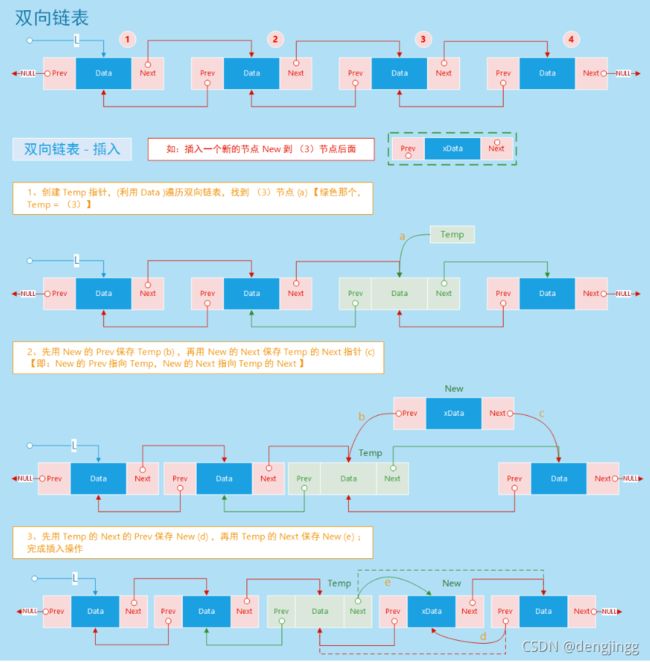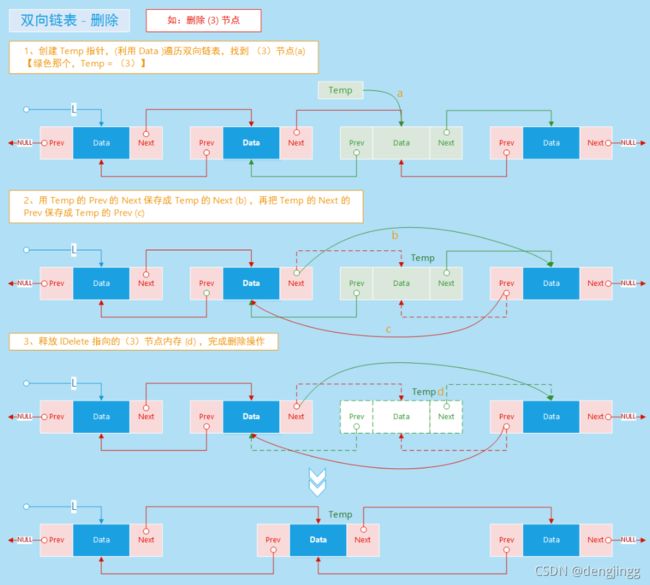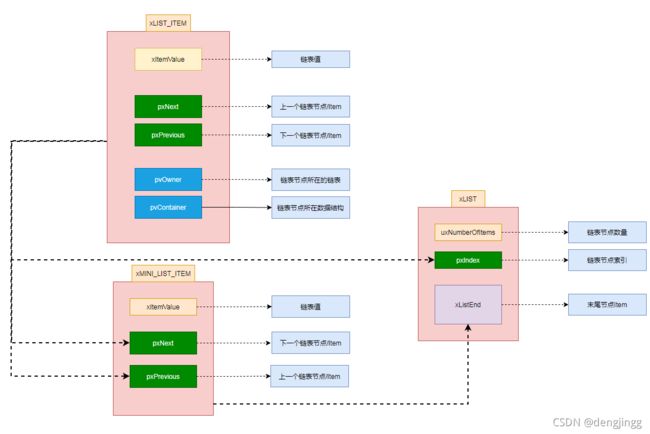freertos 源码解读 list链表图解
FreeRTOS 链表结构图解
本文涉及的FreeRTOS Kernel 代码源文件
FreeRTOS-Kernel-10.4.6\list.c
FreeRTOS-Kernel-10.4.6\include\list.h
零)链表基础
链表分类
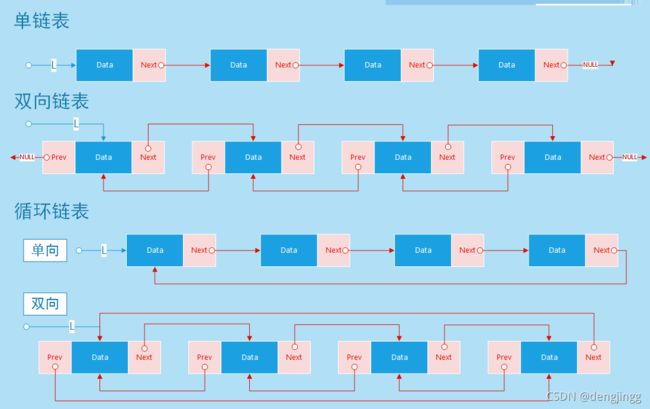
链表分为单链表、双向链表、循环链表(双向、单向)。上图非常清晰
链表操作,FreeRTOS采用双向循环链表
双向链表的删除
阅读完链表的基本操作,开始对freertos的链表做分析
FreeRTOS 链表的结构分解
一)链表的 元素/节点/Item
struct xLIST_ITEM
{
listFIRST_LIST_ITEM_INTEGRITY_CHECK_VALUE /*< Set to a known value if configUSE_LIST_DATA_INTEGRITY_CHECK_BYTES is set to 1. */
configLIST_VOLATILE TickType_t xItemValue; /*< The value being listed. In most cases this is used to sort the list in descending order. */
struct xLIST_ITEM * configLIST_VOLATILE pxNext; /*< Pointer to the next ListItem_t in the list. */
struct xLIST_ITEM * configLIST_VOLATILE pxPrevious; /*< Pointer to the previous ListItem_t in the list. */
void * pvOwner; /*< Pointer to the object (normally a TCB) that contains the list item. There is therefore a two way link between the object containing the list item and the list item itself. */
void * configLIST_VOLATILE pvContainer; /*< Pointer to the list in which this list item is placed (if any). */
listSECOND_LIST_ITEM_INTEGRITY_CHECK_VALUE /*< Set to a known value if configUSE_LIST_DATA_INTEGRITY_CHECK_BYTES is set to 1. */
};
链表节点的结构图
链表值:链表所存值
上一个/下一个集节点:链表的基本结构,指向本身结构体的数据结构
所在链表:节点所处的 链表
所在的数据结构:链表Item作为一个其他数据结构的成员,指向这个结构
二)精简/最小 链表节点/Item
struct xMINI_LIST_ITEM
{
listFIRST_LIST_ITEM_INTEGRITY_CHECK_VALUE /*< Set to a known value if configUSE_LIST_DATA_INTEGRITY_CHECK_BYTES is set to 1. */
configLIST_VOLATILE TickType_t xItemValue;
struct xLIST_ITEM * configLIST_VOLATILE pxNext;
struct xLIST_ITEM * configLIST_VOLATILE pxPrevious;
};
typedef struct xMINI_LIST_ITEM MiniListItem_t;
链表节点的基本形态,主要作用是描述根节点,根节点不需要像平常节点一样保存那么多信息,更多的是表明自己是根节点
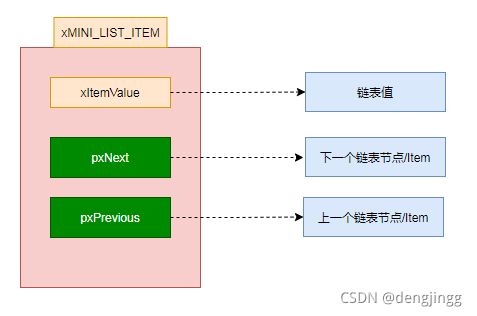
非常基础的链表结构
三)链表
typedef struct xLIST
{
listFIRST_LIST_INTEGRITY_CHECK_VALUE /*< Set to a known value if configUSE_LIST_DATA_INTEGRITY_CHECK_BYTES is set to 1. */
configLIST_VOLATILE UBaseType_t uxNumberOfItems;
ListItem_t * configLIST_VOLATILE pxIndex; /*< Used to walk through the list. Points to the last item returned by a call to listGET_OWNER_OF_NEXT_ENTRY (). */
MiniListItem_t xListEnd; /*< List item that contains the maximum possible item value meaning it is always at the end of the list and is therefore used as a marker. */
listSECOND_LIST_INTEGRITY_CHECK_VALUE /*< Set to a known value if configUSE_LIST_DATA_INTEGRITY_CHECK_BYTES is set to 1. */
} List_t;
五)链表的初始化
void vListInitialise( List_t * const pxList )
{
/* The list structure contains a list item which is used to mark the
end of the list. To initialise the list the list end is inserted
as the only list entry. */
pxList->pxIndex = ( ListItem_t * ) &( pxList->xListEnd ); /*lint !e826 !e740 The mini list structure is used as the list end to save RAM. This is checked and valid. */
/* The list end value is the highest possible value in the list to
ensure it remains at the end of the list. */
pxList->xListEnd.xItemValue = portMAX_DELAY;
/* The list end next and previous pointers point to itself so we know
when the list is empty. */
pxList->xListEnd.pxNext = ( ListItem_t * ) &( pxList->xListEnd ); /*lint !e826 !e740 The mini list structure is used as the list end to save RAM. This is checked and valid. */
pxList->xListEnd.pxPrevious = ( ListItem_t * ) &( pxList->xListEnd );/*lint !e826 !e740 The mini list structure is used as the list end to save RAM. This is checked and valid. */
pxList->uxNumberOfItems = ( UBaseType_t ) 0U;
/* Write known values into the list if
configUSE_LIST_DATA_INTEGRITY_CHECK_BYTES is set to 1. */
listSET_LIST_INTEGRITY_CHECK_1_VALUE( pxList );
listSET_LIST_INTEGRITY_CHECK_2_VALUE( pxList );
}

空链表初始化,因为末尾节点是存在的所以初始化就是把ListEnd进行装填
因为只有一个元素
当前索引,上一个/下一个Item 都指向唯一的节点ListEnd,End需要保持在末尾所以ItemValue为数据结构最大值FFFF(freertos的链表排序依照ItemValue大小排序)
ListEnd末尾元素是为了链表抽象结构而存在的,本身没有数据意义。此时链表数据记为 0
六)链表操作
void vListInsertEnd( List_t * const pxList, ListItem_t * const pxNewListItem )
void vListInsert( List_t * const pxList, ListItem_t * const pxNewListItem )
UBaseType_t uxListRemove( ListItem_t * const pxItemToRemove )
FreeRtos 的链表是专用的,所以在结构定义上有它自己的特点。归根结底它还是链表,有着基本的链表结构(数据,前指针,后指针)。那么基本的数据操作也是适用的。
链表的删除动作,请产考文章开头的链表图解链表元素删除动作
freertos的链表节点是按照Value值排序的,做操作的时通过Value值找到索引,并且有index的概念
UBaseType_t uxListRemove( ListItem_t * const pxItemToRemove )
{
/* The list item knows which list it is in. Obtain the list from the list
item. */
List_t * const pxList = ( List_t * ) pxItemToRemove->pvContainer;
pxItemToRemove->pxNext->pxPrevious = pxItemToRemove->pxPrevious;
pxItemToRemove->pxPrevious->pxNext = pxItemToRemove->pxNext;
/* Only used during decision coverage testing. */
mtCOVERAGE_TEST_DELAY();
/* Make sure the index is left pointing to a valid item. */
if( pxList->pxIndex == pxItemToRemove )
{
pxList->pxIndex = pxItemToRemove->pxPrevious;
}
else
{
mtCOVERAGE_TEST_MARKER();
}
pxItemToRemove->pvContainer = NULL;
( pxList->uxNumberOfItems )--;
return pxList->uxNumberOfItems;
}
链表的插入动作。操作请参考文章开头图片,请注意pxIndex的位置从而确定在什么位置加入新节点

在void vListInsert( List_t * const pxList, ListItem_t * const pxNewListItem )
{
ListItem_t *pxIterator;
const TickType_t xValueOfInsertion = pxNewListItem->xItemValue;
/* Only effective when configASSERT() is also defined, these tests may catch
the list data structures being overwritten in memory. They will not catch
data errors caused by incorrect configuration or use of FreeRTOS. */
listTEST_LIST_INTEGRITY( pxList );
listTEST_LIST_ITEM_INTEGRITY( pxNewListItem );
/* Insert the new list item into the list, sorted in xItemValue order.
If the list already contains a list item with the same item value then the
new list item should be placed after it. This ensures that TCB's which are
stored in ready lists (all of which have the same xItemValue value) get a
share of the CPU. However, if the xItemValue is the same as the back marker
the iteration loop below will not end. Therefore the value is checked
first, and the algorithm slightly modified if necessary. */
if( xValueOfInsertion == portMAX_DELAY )
{
pxIterator = pxList->xListEnd.pxPrevious;
}
else
{
/* *** NOTE ***********************************************************
If you find your application is crashing here then likely causes are
listed below. In addition see http://www.freertos.org/FAQHelp.html for
more tips, and ensure configASSERT() is defined!
http://www.freertos.org/a00110.html#configASSERT
1) Stack overflow -
see http://www.freertos.org/Stacks-and-stack-overflow-checking.html
2) Incorrect interrupt priority assignment, especially on Cortex-M
parts where numerically high priority values denote low actual
interrupt priorities, which can seem counter intuitive. See
http://www.freertos.org/RTOS-Cortex-M3-M4.html and the definition
of configMAX_SYSCALL_INTERRUPT_PRIORITY on
http://www.freertos.org/a00110.html
3) Calling an API function from within a critical section or when
the scheduler is suspended, or calling an API function that does
not end in "FromISR" from an interrupt.
4) Using a queue or semaphore before it has been initialised or
before the scheduler has been started (are interrupts firing
before vTaskStartScheduler() has been called?).
**********************************************************************/
for( pxIterator = ( ListItem_t * ) &( pxList->xListEnd ); pxIterator->pxNext->xItemValue <= xValueOfInsertion; pxIterator = pxIterator->pxNext ) /*lint !e826 !e740 The mini list structure is used as the list end to save RAM. This is checked and valid. */
{
/* There is nothing to do here, just iterating to the wanted
insertion position. */
}
}
pxNewListItem->pxNext = pxIterator->pxNext;
pxNewListItem->pxNext->pxPrevious = pxNewListItem;
pxNewListItem->pxPrevious = pxIterator;
pxIterator->pxNext = pxNewListItem;
/* Remember which list the item is in. This allows fast removal of the
item later. */
pxNewListItem->pvContainer = ( void * ) pxList;
( pxList->uxNumberOfItems )++;
}
本文开头零章 使用 了 “半纸渊”博主的图片,在此注明
